
141 tonnes: Thomas Wunderle transports a complete building facade
Story
When facades and entire houses move, experts such as JaKo Baudenkmalpflege and Max Wild are called upon. And heavy-duty wizards such as the Actros 4163. At the wheel: Thomas Wunderle.
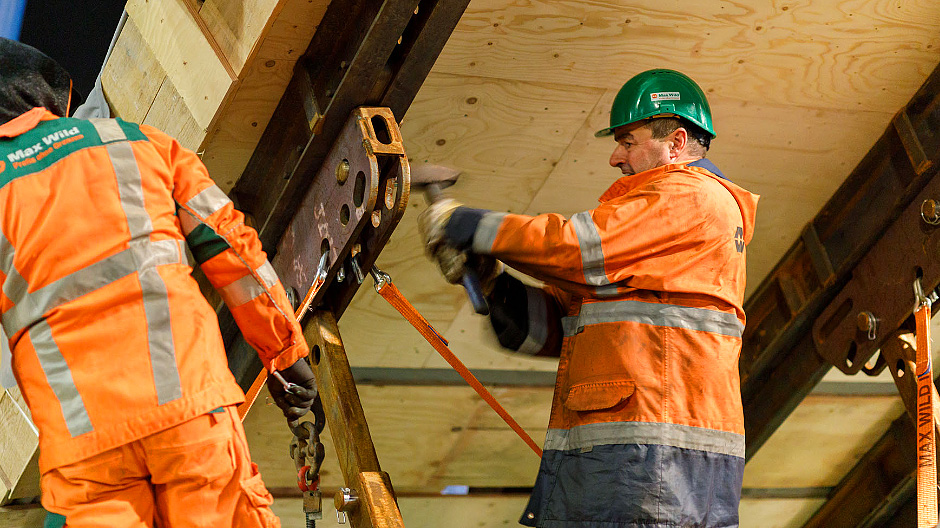
The facade hangs from two truck-mounted cranes like a theatre backdrop – 21 metres long, around five metres high and just under a metre wide. What may seem like nothing much here, despite its size, is a piece of Hamburg cityscape: the facade of a house from the late nineteenth century. Just over a year ago, JaKo Baudenkmalpflege divided up the entire facade floor by floor and separated it from the rest of the building. Seven parts in total were then stored in an industrial estate. Now, they are being transported back. JaKo relies on the expertise of Max Wild for transport and demolition work. A vital part of this: Thomas Wunderle and his Actros of up to 250 tonnes.
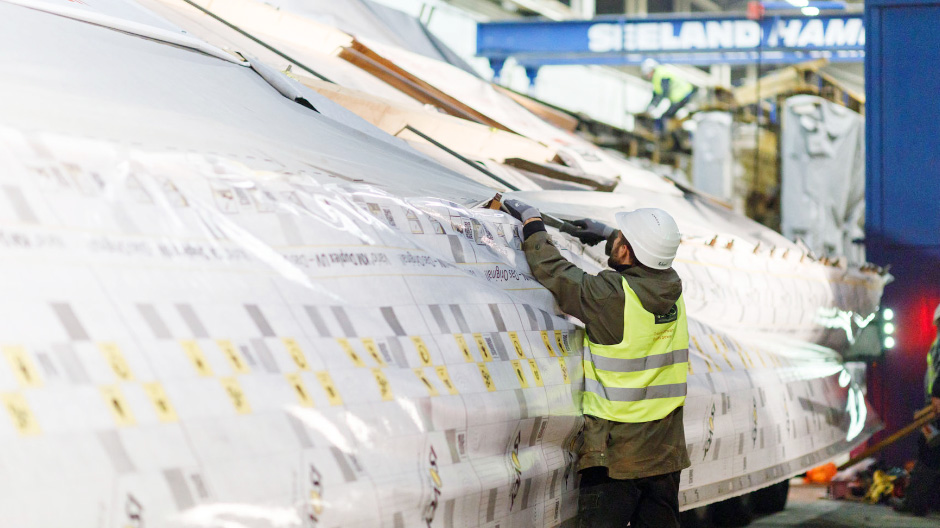
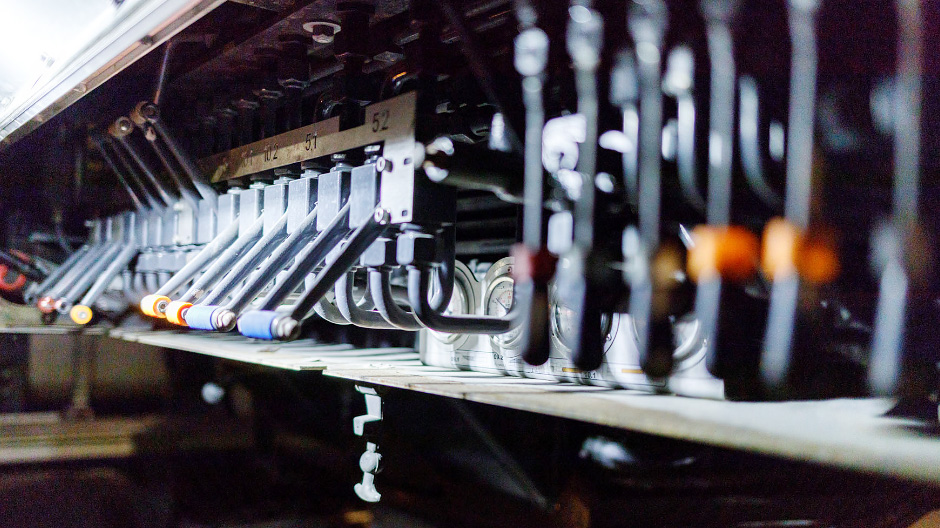
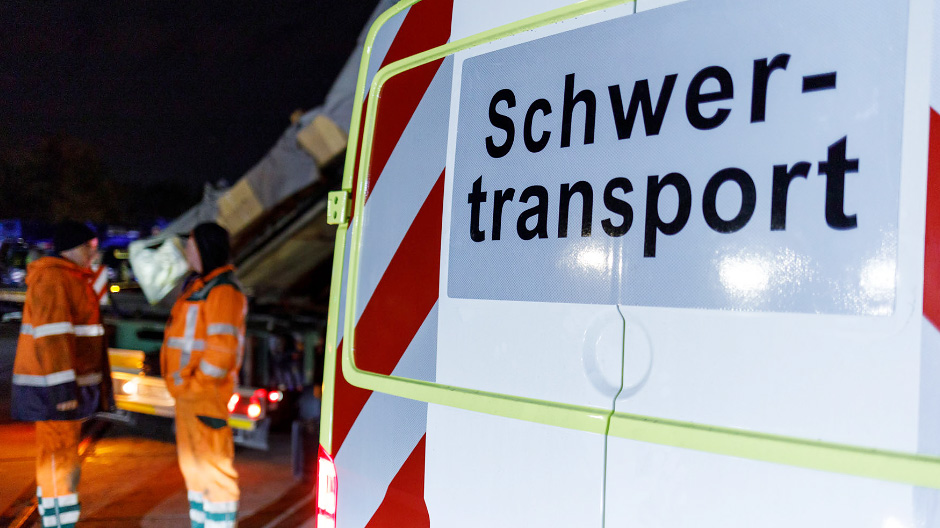
Waiting for approval of the route.
With powerful hammer blows, Thomas drives a locking pin into the steel structure, holding the facade in position. Around 20 employees from JaKo and Max Wild work at full speed, ensuring they will be ready to go as soon as the route is cleared. An expert first checks the width, length and height of the truck and trailer. As well as the number of axles and the respective weight. 141 tonnes, 4.8 metres wide, 4.4 metres high, 32 metres long.
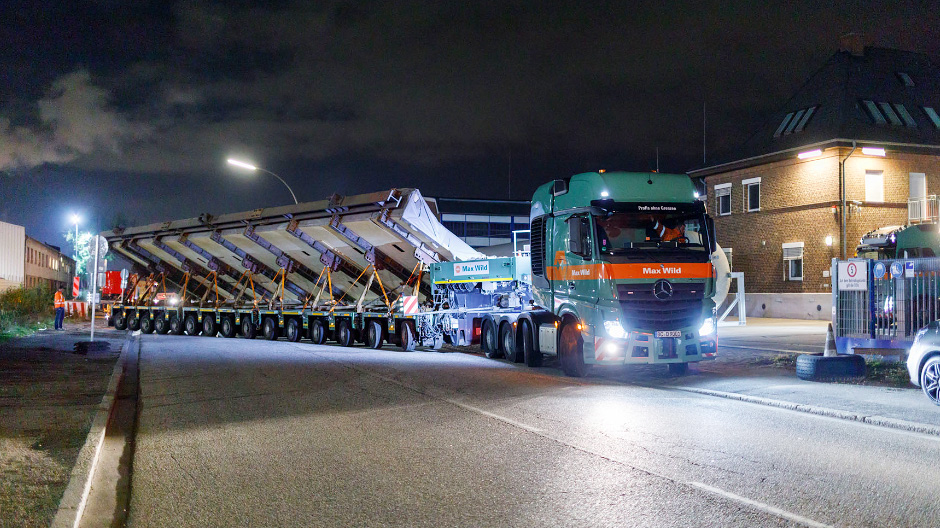
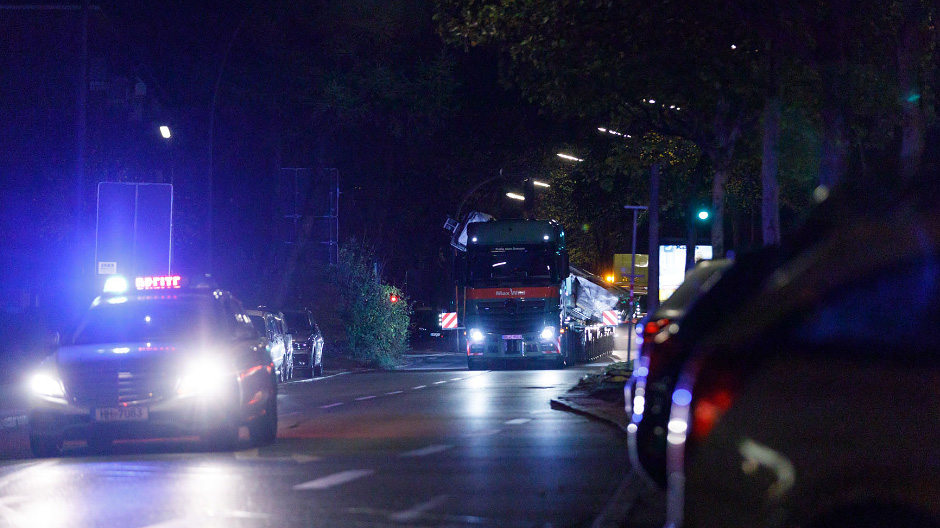
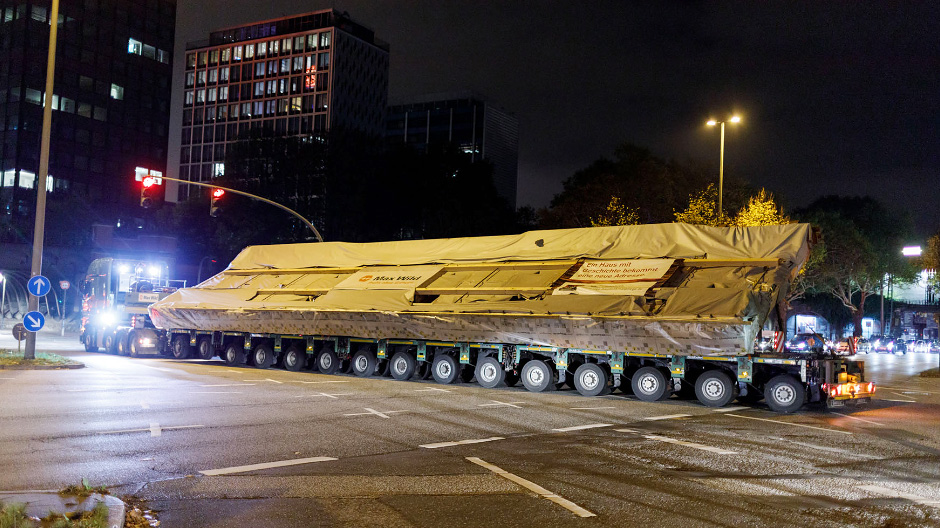
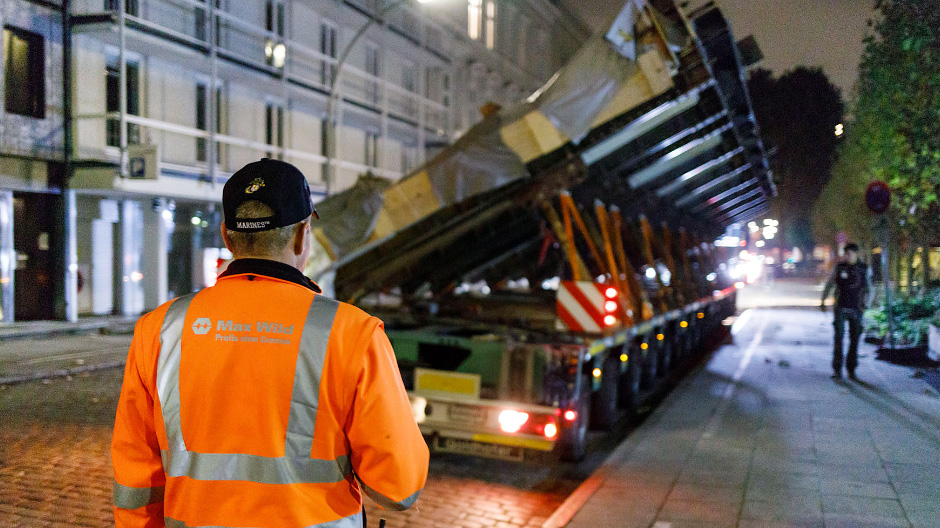
141 tonnes hit the road.
10 p.m. The green light is given over the radio. Thomas glances in his right-hand mirror and takes his foot off the brake. The 19 axles start to move slowly, moving in reverse through the gate of the storage site onto the road. Thanks to the rear axles with forced steering, the flatbed truck is remarkably agile. The destination is seven kilometres away in the centre of Hamburg. Thomas knows the route. “It’s important that we examine everything in advance and be prepared for every eventuality.” At the very top of this list are bridges. If the route takes the truck over one, the bridge must be able to support its considerable weight. If it goes under one, the height must be right. Making a few skilful turning manoeuvres, Thomas avoids three of these obstacles today.
However, he can’t get around the Kennedy bridge over the Alster. The most difficult part begins at the crossroads just after it. His destination is at the end of a cul-de-sac. He therefore has to approach the construction site in reverse. The police momentarily block the crossroads. Thomas’ colleague goes to the back of the load and gives him some instructions. Even this does not unsettle the driver. “It’s pretty easy here, no incline, no bends,” he says. Five minutes later and the first part of the facade has reached its destination.
This article contains additional material (videos, images and reports etc.) for registered RoadStars members. In order to experience the article to the full, you need to log in with your RoadStars account or register for one free of charge.
Become a RoadStar and gain access to exclusive content and campaigns!
Login for RoadStars members
Not yet a member? Join RoadStars now
Obtain exclusive access to exciting events and activities which only RoadStars can offer.
Join RoadStarsUnloading the next day.
The next afternoon. Thomas’ job is not yet done. He spent the night in his Actros. The lorry driver has been on the road with the 4163 for three years and is very impressed: “The Turbo Retarder Clutch is really great. Previously, I had to do all the manoeuvring using the regular clutch. You would always be afraid that the load would stop.” With over 20 years of experience transporting heavy loads and eight years working at Max Wild, he knows what he is talking about. He recalls the first time he drove the Actros. “I had to get to an extremely narrow construction site. There were just a few centimetres space on each side. It was back and forth, back and forth, and the Turbo Retarder Clutch did a really good job. I knew the system was excellent after that.”
The Turbo Retarder Clutch helps Thomas again now. He takes his foot off the brake and lets the truck roll back the last few metres. Now, he no longer needs to drive, just monitor.
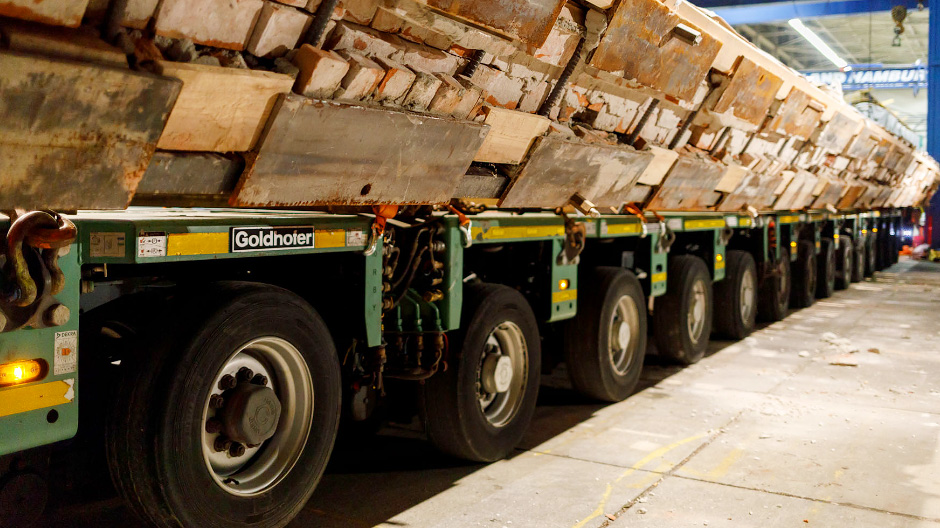
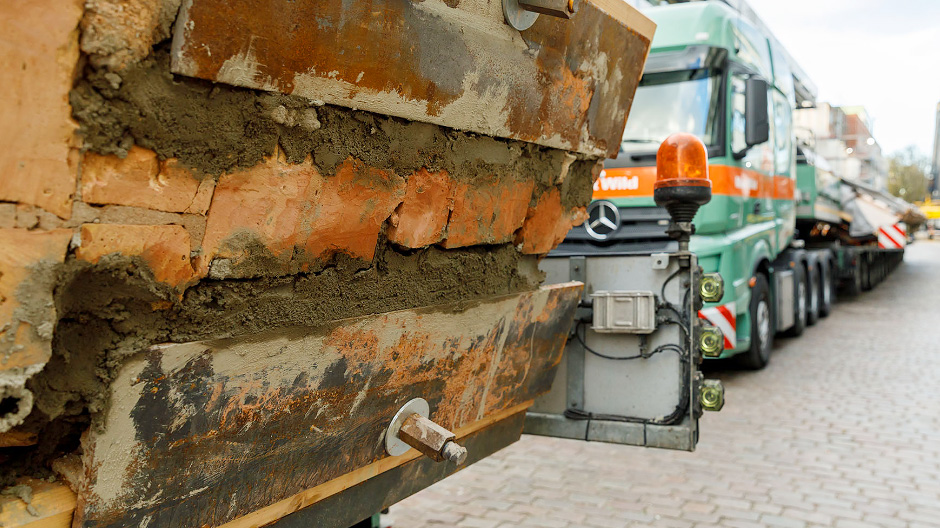
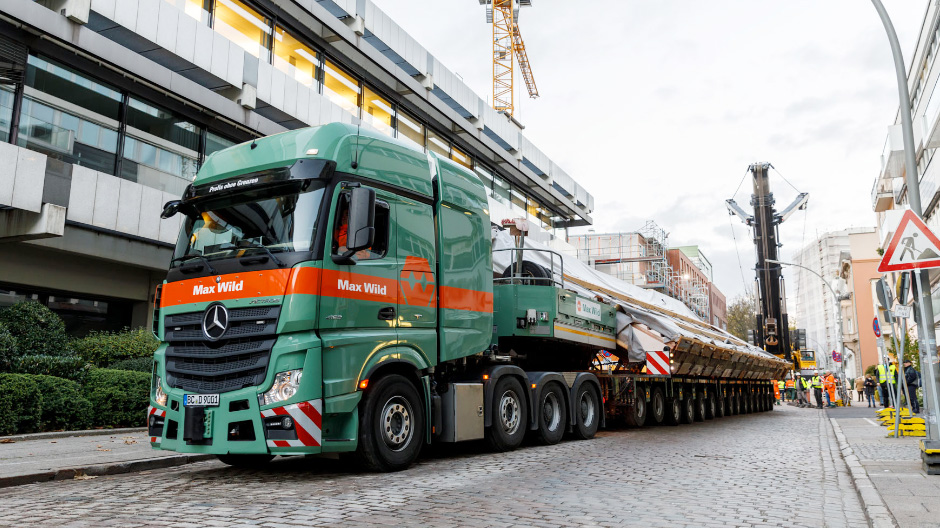
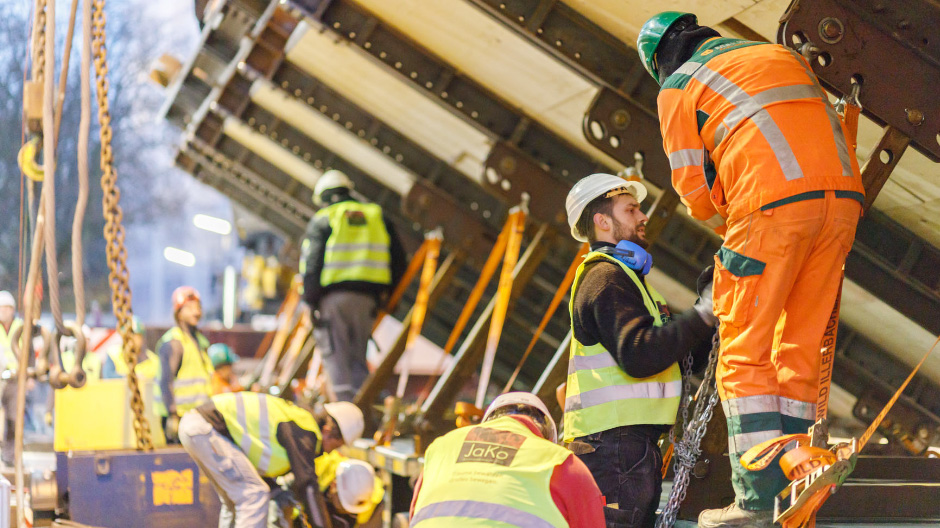
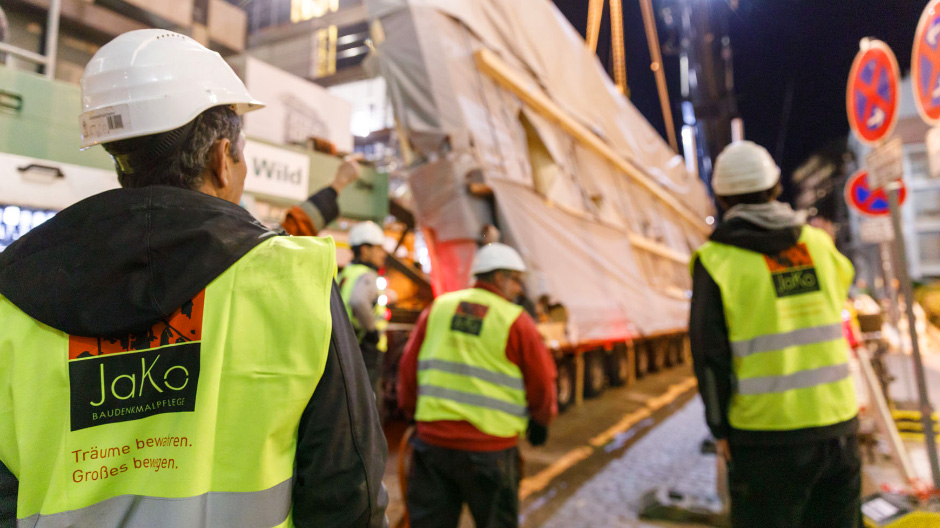
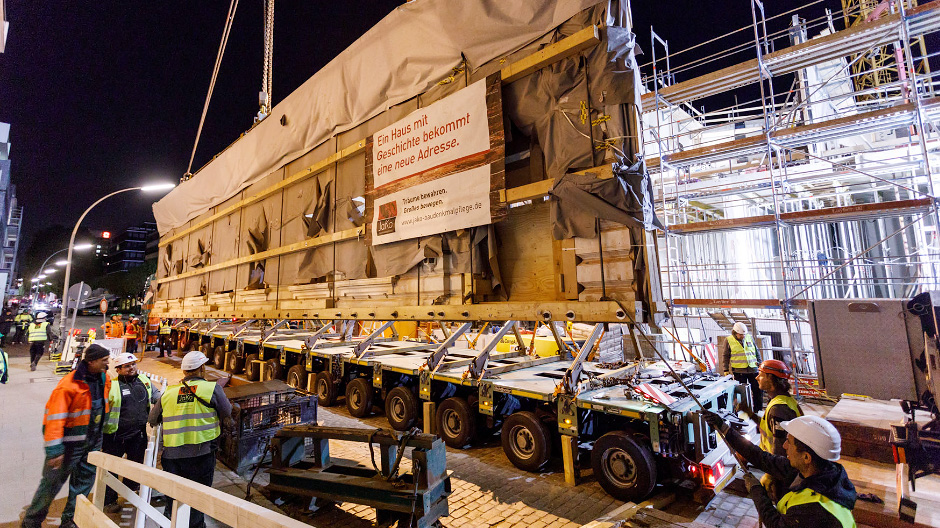
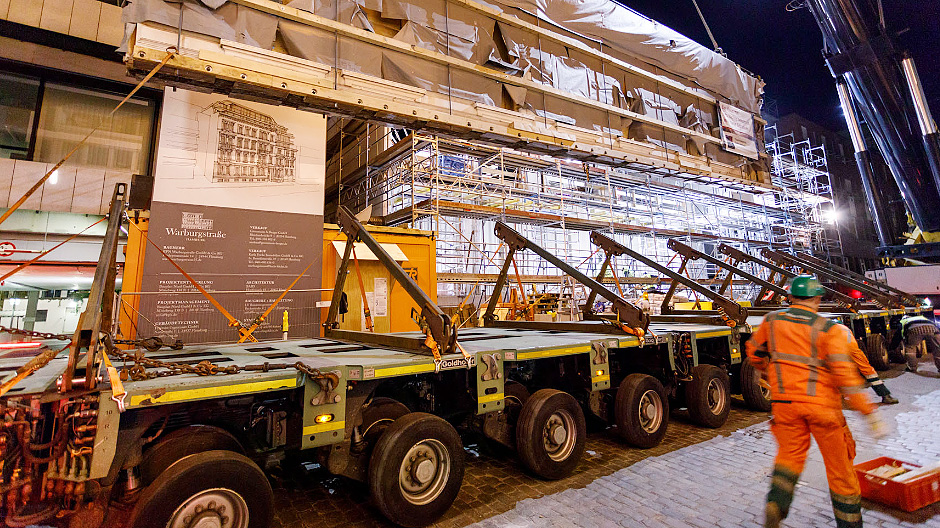
Back in place.
The JaKo Baudenkmalpflege team attaches the cables to the facade using huge shackles. Thomas swings the hammer – the locking pins have to be knocked out again. Afternoon has now turned into evening. Under the bright spotlight of the crane, the facade is lifted up. The structure, which is over 100 years old, is repositioned at the front of the new building and fixed in place. And as it is slowly brought back to its proper position, Thomas is already thinking about the second floor and the next facade that he now has to pick up.
Translocation.
Translocation designates the displacement of part of a building or an entire building.
Often it involves houses which are particularly old or especially worthy of being kept. The elements are secured, packed and separated at appropriate positions.
In this case, the entire façade was reduced floor by floor into transportable elements before the rest of the building was demolished and replaced by a new construction.
After the individual components were pieced back together, the separation points are no longer visible.
Pulling away.
The dry clutch is open when pulling away. The power is channelled to the transmission input shaft via the pump impeller and turbine wheel of the oil-filled turbo clutch. Pulling away therefore occurs wear-free. The quantity of the oil is steplessly adjustable and varies in accordance with the torque.
Driving.
After the vehicle has pulled away, the friction clutch closes and transmits the torque. The turbo retarder clutch is emptied. A purely mechanical drivetrain with very high levels of efficiency is thus created. In manoeuvring mode, even without actuating the accelerator pedal, oil fills the space between the vanes and creates traction. The truck can then be positioned in a controlled manner using the brake pedal.
Braking.
As a primary retarder, the system uses the transmission ratios, thus even at low vehicle speeds, high braking torque is available. Upon actuating the retarder, the turbine wheel is stopped by the turbine brake on the housing. Oil flows between the two vane wheels and creates a braking torque at the impeller. The braking torque acts upon the vehicle via the closed friction clutch and the transmission.
Photos: Christoph Börries




Comment
Please log in to post a comment.
15 comments
Driving is a tough job. The smarter you are, the smoother the road.
Das gilt besonders für den Schwertransport.
Driving is a tough job. The smarter you are, the smoother the road.
Das gilt besonders für den Schwertransport.
CADA DIA APRENDES COSAS NUEVAS SOBRE LA MECANICA
GRACIAS.
CADA DIA APRENDES COSAS NUEVAS SOBRE LA MECANICA
GRACIAS.
Auf der IAA hab ich mir den angeschaut und die Turbo-Retarder-Kupplung der Abzulute Wahsinn !! Was für eine Technik !!!!!!
Würde ich gerne mal Fahren auch im Kipper lieferbar laut Verkäufer.
Gruss an Thomas
Ein mega Job ziehe meinen Hut ......
Gruss Andeas
Auf der IAA hab ich mir den angeschaut und die Turbo-Retarder-Kupplung der Abzulute Wahsinn !! Was für eine Technik !!!!!!
Würde ich gerne mal Fahren auch im Kipper lieferbar laut Verkäufer.
Gruss an Thomas
Ein mega Job ziehe meinen Hut ......
Gruss Andeas
So ein Schwertransporter ist bestimmt jeden Tag eine neue Herausforderung ich wünsche dir viel Spaß damit und immer eine Handbreit Platz unter der Last 👍😎😀
So ein Schwertransporter ist bestimmt jeden Tag eine neue Herausforderung ich wünsche dir viel Spaß damit und immer eine Handbreit Platz unter der Last 👍😎😀
Grüße auch noch an die Kollegen von der Firma Max Wild, die meiner Heimat dem Allgäu sehr nahe sind.
Grüße auch noch an die Kollegen von der Firma Max Wild, die meiner Heimat dem Allgäu sehr nahe sind.